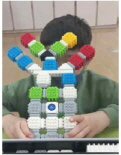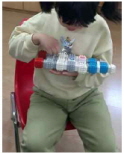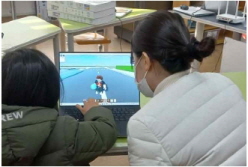
발달장애학생 대상 인공지능 교육프로그램 개발 연구
Copyright ⓒ 2024 The Digital Contents Society
This is an Open Access article distributed under the terms of the Creative Commons Attribution Non-CommercialLicense(http://creativecommons.org/licenses/by-nc/3.0/) which permits unrestricted non-commercial use, distribution, and reproduction in any medium, provided the original work is properly cited.

초록
이 연구의 목적은 발달장애학생을 대상으로 인공지능에 대한 학습(learning about AI)을 위한 교육프로그램을 개발하는 것이다. 연구의 방법으로는 교수설계 모형인 분석, 설계, 개발, 실행, 평가의 단계를 포함하고 있는 ADDIE 모형을 택하여 총 10차시의 교육프로그램을 개발하였다. 개발한 프로그램의 현장 적용성 및 개선점을 파악하기 위해 충청남도 소재의 A특수학교에서 발달장애 초등학생 5명을 대상으로 2주간 프로그램을 실행하였고 교사의 심층 면담 결과를 주제 분석 방법을 통해 분석하여 개선점을 도출하고 교육프로그램을 수정하였다. 연구 결과, 인공지능의 기본 이해 학습, 인공지능과 관련된 기본적인 도구 활용, 인공지능의 특성 이해 및 활용 교육을 포함하여 총 10차시의 교육프로그램을 개발하였다. 발달장애학생의 인공지능에 대한 학습은 개인적 편리와 사회적 통합을 가능하게 하는 필수요소가 될 것으로 기대되며, 교육적 효과를 증진하기 위해서는 맞춤형 학습이 이루어지기 위한 교수적 수정이 동반되어야 한다.
Abstract
This study aims to develop an education program on learning about artificial intelligence (AI) for students with developmental disabilities. The researchers adoped the ADDIE model to design and develop a 10-session educational program. To assess the practicality of the developed program and identify improvement areas, the researchers implemented a two-week program involving five elementary school students with developmental disabilities at a special school in Chungcheongnam-do, South Korea; further, in-depth teacher interviews were conducted to extract points for improvement and to modify the educational program accordingly. As a result, a 10-session educational program was developed, encompassing the understanding of AI basics, practical use of fundamental AI-related tools, and the understanding and application of AI characteristics. In conclusion, learning about AI is expected to become essential for the personal convenience and social integration of students with developmental disabilities. To improve the educational effectiveness of this endeavor, pedagogical modifications for personalized learning must accompany educational program development.
Keywords:
Artificial Intelligence, ADDIE Model, Learning about AI, Instructional Design, Developmental Disabilities키워드:
인공지능, ADDIE 모형, 인공지능에 대한 학습, 교수설계, 발달장애Ⅰ. 서 론
인공지능(AI)이나 빅데이터 등 첨단기술의 발달과 함께 사회의 모습이 변화하면서 교육의 모습도 빠르게 변화하고 있다. 특히 4차산업 혁명의 핵심 기술인 인공지능(AI) 기술이 교육에 도입되면서 교육의 체제, 내용, 방법 등에서 다양한 변화가 이루어지고 있다[1]. 이와 더불어 인공지능 기술을 교육에 접목하는 인공지능의 교육적 활용(Artificial Intelligence in Education: AIEd)이 학습자의 학업성취도와 만족도 향상을 목적으로 활용되고 있다[2]-[4]. 인공지능의 교육적 활용은 인공지능에 대한 학습(learning about AI)과 인공지능과 함께하는 학습(learning with AI)으로 구분될 수 있다[5]. 그중에서 인공지능에 대한 학습(learning about AI)은 정규 교육과정 내에서 지속적으로 확대되어 오고 있다. 2022 개정 교육과정 총론에서는 모든 교과교육을 통해 학생이 디지털 기초소양을 함양할 수 있도록 하는 것을 목표로 정보 교육과정과 연계하는 교육과정 편성 기준을 제시하였다. 이렇듯 디지털 활용 능력과 인공지능과 관련된 소양은 우리 삶에서 필수적인 능력으로 생각되기 때문에 이를 함양시키기 위한 국가적 차원의 노력이 계속되고 있다. 나아가 비장애학생의 경우, 컴퓨팅 사고력을 바탕으로 인공지능의 기술을 활용하여 창의적인 산출물을 만들어 낼 수 있는 역량을 향상하는 것을 최종 목표로 하고 있다[6].
이러한 인공지능에 대한 관심은 특수교육과 관련된 다양한 영역에도 반영되고 있다. 장애학생을 위한 인공지능에 대한 관심은 삶의 질 향상을 위한 보조공학으로서의 인공지능 기술[7],[8]이나 의사소통 중재를 위한 활용[9], 장애학생의 교과교육 또는 직업교육을 위한 스마트 러닝 차원의 활용[10],[11] 등 교육과 일상생활 전반에서 인공지능 기술을 활용하는 것에서부터 시작되었다. 최근 인공지능이 무엇인지, 그리고 그것이 삶에 어떤 영향을 끼칠 것인지 이해해야지만 인공지능을 활용한 생활이 가능할 것이라는 기대가 커지면서[12], 장애학생의 컴퓨팅 사고와 인공지능에 대한 기본적인 이해의 중요성도 날로 커지고 있다. 이에 2022 개정 특수교육 교육과정의 다양한 측면에서 이를 반영하고 있으며, 국립특수교육원에서는 2019년부터 2022년까지 장애 영역별로 피지컬컴퓨팅, 언플러그드 등의 SW교육콘텐츠를 개발하고 보급해 오고 있다. 이렇게 기초소양으로의 인공지능에 대한 학습(learning about AI)의 중요성과 관심이 커지고 있다.
하지만, 특수교육 영역에서는 아직 인공지능이나 컴퓨팅 사고 자체에 대한 교육 및 관련 연구는 거의 이루어지지 않고 있다. 일부 교과 수업에서 이루어지는 장애학생을 대상으로 하는 인공지능 교육프로그램은 비장애학생을 대상으로 하는 교육프로그램을 부분적으로 적용하거나 난이도를 조정하는 등 장애학생의 특성과 요구를 반영하지 못하는 경우가 많다. 특히 발달장애학생의 경우, 컴퓨팅 사고나 인공지능에 대한 학습능력이 스스로의 학습과 사고를 관리하는 데 긍정적 영향을 주어 발달장애를 포함한 학습적, 인지적 어려움이 있는 이들에게 효과적이다. 하지만 현재 이루어지고 있는 공학적인 접근성 향상을 위한 보조기기 지원이나 매체의 수정이라는 방법만으로는 인공지능에 대한 학습(learning about AI)에 어려움이 있다.
이에 이 연구에서는 실제 특수교육 현장의 요구를 반영하는 동시에 발달장애학생의 인공지능에 대한 학습 및 관련 역량을 향상을 위한 교육프로그램을 체계적으로 개발하고자 한다. 이 연구의 구체적인 연구 문제는 다음과 같다.
첫째, 발달장애 초등학생을 위한 인공지능에 대한 학습(learning about AI) 교육프로그램은 어떻게 설계되고 개발될 수 있는가?
둘째, 발달장애 초등학생을 위한 인공지능에 대한 학습(learning about AI) 교육프로그램의 현장 적용성 및 학습 효과성을 높이기 위해 유의해야 하는 점은 무엇인가?
Ⅱ. 연구 방법
이 연구에서는 발달장애 초등학생을 대상으로 총 10차시의 인공지능 교육프로그램 개발하고 운영하였다. 인공지능에 대한 기본적인 이해 학습, 인공지능과 관련된 기본적인 도구 활용, 인공지능의 특성 이해 및 활용 교육을 포함하여 총 10차시의 교육프로그램을 개발하였고 하루에 1차시(40분)씩 10일 동안 수업을 운영하였다. 구체적인 연구 대상 및 절차는 아래와 같다.
2-1 연구 대상
해당 수업에 참여한 인원은 교수자, 학습 도우미와 학습자다. 학습자의 경우 총 5명이며, 교수자 1명, 실무원을 포함한 4명의 학습 도우미가 수업에 함께 참여할 수 있도록 배정하였다. 인공지능 관련 교육프로그램의 특성상 학습자가 실습하는 차시가 큰 비중을 차지하기 때문에 교수자와 학습자의 비율을 1:1로 맞추었다. 해당 연구에 참여한 교수자는 현직 초등학교 교사로 초등학생을 대상으로 SW 교육 및 기초코딩교육 관련 경력(약 3년)이 있다.
또한 본 연구 시작 전에, 교수자에게 연구에 대한 구체적인 설명과 연구 참여 동의서를 받았다. 연구 참여 동의서에는 개인정보 보호 및 제시한 의견에 대한 비밀 보장에 대한 내용이 포함되어 있으며 참여를 원하지 않을 경우 언제라도 연구를 중단할 수 있음을 안내하였다. 또한 연구참여자 교사에게 연구를 위해 수집된 자료 일체는 연구의 목적 외에 다른 용도로 사용하지 않을 것을 언급하고 약속하였다.
2-2 연구 절차
본 연구는 발달장애학생을 위한 인공지능 교육프로그램을 개발하기 위해 교수설계모형인 ADDIE의 절차[13]를 따라 수업을 설계하고 운영하였다. A(Analyze: 분석) 단계에서는 학습자 분석, 환경 분석, 내용 분석을 진행하였다. 학습자 분석의 경우, 발달장애학생의 인지적 특성, 언어 및 사회성을 조사하고 분석하였다. 환경 분석의 경우, 인공지능 교육프로그램을 운영하기에 적합한 형태로 환경을 구축하기 위해 인터넷 등을 포함한 오프라인 환경, 실습 도구 등을 포함한 교육 도구를 분석하였다. 내용 분석의 경우 국립특수교육원에서 발간한 SW교육콘텐츠(2019~2022)를 비롯하여 실생활에서 발생할 수 있는 문제 상황 등을 분석하였다. D(Design: 설계) 단계에서는 발달장애학생을 위한 인공지능 교육프로그램 설계를 위해 교육프로그램 개발 방향을 설정하고, 이에 따른 수업 내용 설계, 활동 설계를 진행하였다. D(Development: 개발) 단계에서는 발달장애학생을 위해 총 10차시의 인공지능 교육프로그램을 개발하였고 실제 교육에서 활용될 학습자료(수업지도안)를 작성하였다. 또한 I(Implementation: 실행) 단계에서는 프로그램의 적용 가능성 및 개선점을 도출하여 프로그램의 현장 적용 가능성을 높이기 위해 총 2주에 걸쳐 10주차 수업을 진행하였다. 이후 E(Evaluation: 평가) 단계에서는 개발된 인공지능 교육프로그램의 장단점 및 개선할 점에 대해서 교수자의 의견을 살펴보았다. 연구의 절차를 요약하면 표 1과 같다.
Ⅲ. 연구 결과
본 연구는 교수설계모형인 ADDIE를 기반으로 장애학생 대상 인공지능 교육프로그램 개발하는 것에 그 목적이 있다. 이를 위해 10차시의 내용으로 발달장애학생을 위한 프로그램을 개발하였고 이를 실행한 교사의 의견을 분석하여 유의점과 개선점을 도출하였다.
3-1 발달장애학생 대상 인공지능 교육프로그램 설계 및 개발
분석 단계에서는 학습자 분석, 환경 분석, 내용 분석을 진행하였다. 학습자 분석의 경우, 교육프로그램을 활용하게 될 발달장애학생(초등학생)의 특성을 분석하였다. 발달장애학생은 과제에 집중하는 시간이 짧고, 주요 자극을 변별하여 주의를 기울이는 선택적 주의집중과 단기기억 영역에 어려움이 있다는 인지적 특성이 있다. 그리고 관찰이나 모방을 통한 모방학습, 우발 학습의 능력이 부족하며, 학습한 기술을 다른 상황에 적용하는 일반화에 어려움이 있다. 언어 및 사회성의 측면에서는 언어 발달이 지체되거나 상호작용 방법의 이해 부족, 빈약한 자아개념 등으로 사회성 발달에 있어서 문제를 보인다. 또한 학습 상황에서 실패 경험이 많기 때문에 학습된 무기력이나 실패를 예상하여 회피하는 경향을 보이기도 하며, 문제해결에 있어 타인이나 외적인 단서에 의존하려는 성향을 나타내기도 한다.
환경 분석의 경우, 프로그램의 현장 적용 가능성을 높이기 위해 10차시 수업을 진행할 천안 소재 특수학교의 오프라인 환경을 분석하였다. 오프라인 환경의 경우, 인공지능 교육프로그램을 실행하기에 적합한 환경이 구축되어 있는지 교육 도구, 인터넷 환경 등을 분석하였다. 활용하고자 하는 특수학교의 교실에는 인공지능 교육프로그램을 실행하기에 충분한 인터넷 환경이 구축되어 있었다. 또한 교육 도구의 경우 학생 수에 맞게 노트북, 학생 티처블 머신(Teachable Machine)의 일종인 코딩 블록, 일반 블록 등의 교육 도구를 준비하였다.
내용 분석의 경우, 실생활 중심의 기능적인 내용을 습득하게 하고자, 특수교육대상 학생의 특성과 학습 수준을 고려하여 주제 중심의 교육프로그램 구성하고자 하였다. 국립특수교육원에서 발간한 SW교육콘텐츠(2019~2022)의 내용을 분석하였다. SW교육콘텐츠의 경우, 각 연도에 개발된 콘텐츠마다 차이가 있었다. 2019년도에는 시각장애, 청각장애, 지체장애, 발달장애별로 콘텐츠가 개발되었고 코딩, 언플러그드 활동 위주로 주제가 구성되어 있었다. 다만 초·중등의 구분이 없어 실제 현장에 적용할 프로그램을 선정하는 것에는 어려움이 있었다. 2020~2022년도에는 언플러그드, 피지컬 컴퓨팅, 문제해결중심 SW교육, AI교육(기본, 심화) 콘텐츠 등 주제 중심으로 콘텐츠가 개발되었다. 하지만 장애유형별로 콘텐츠 개발이 되지 않고 기개발된 프로그램-신규프로그램의 유기성이 떨어진다는 한계를 보였다.
발달장애학생 대상의 수업 설계를 위해 설계원리 도출, 설계원리 적용 수업 내용 및 활동 설계를 진행하였다. 이를 위해 인공지능 관련 교육과 관련한 선행 문헌을 분석하여 설계원리를 도출하였고, 도출한 설계원리를 적용하여 ‘수업 전·중·후’로 구분하여 10차시의 수업을 설계하였다. 수업 내용의 경우, 크게 인공지능의 기본적인 이해를 위한 이론 수업(10차시 중 총 1차시), 인공지능의 특성을 활용한 실습 수업(10차시 중 총 9차시)으로 구성하였다. 인공지능의 기본적인 이해를 위한 이론 수업(1차시)에서는 인공지능이 무엇인지 알고 인공지능 기술이 실생활에 쓰이는 사례를 알아보는 활동으로 구성하였다. 나머지 9차시는 인공지능의 특성을 활용한 실습 수업으로 구성하였다. 인공지능 특성을 활용한 수업은 크게 세 영역으로 구성하였다. 첫째, 기본적인 교육 도구인 컴퓨터, 티처블머신을 사용하는 방법을 이해하고 익히는 활동, 둘째 인공지능의 기본적인 특성(예: 순차, 반복, 규칙)에 대해 학습하는 활동(플레이도우, 블록 등을 통한 언플러그드 활동, 티처블머신 관련 활동), 인공지능의 기본적인 특성을 활용하여 코딩하는 활동으로 구성하였다. 발달장애학생을 위한 인공지능 교육프로그램 체계는 아래의 표 3과 같다.
1차시에서는 ‘인공지능 기술이 무엇인지 말할 수 있으며 이것이 생활 속에서 어떻게 활용되는지 설명할 수 있다.’라는 학습목표로 인공지능에 대한 기본적인 이해 학습을 위해 인공지능의 뜻을 알아보고 인공지능 기술이 적용된 사례를 살펴보는 활동을 구성하였다. 1차시의 구체적인 내용은 표 4와 같다.
2∼3차시에서는 본격적으로 실습이 이루어지며 ‘마우스, 키보드 등 컴퓨터를 사용하는 방법을 익히고 이에 따라 컴퓨터를 조작할 수 있다.’, ‘티처블머신인 코딩블록의 기능 및 조작방법을 이를 조립할 수 있다.’, ‘센서 블록의 기능 및 조작 방법을 알고 조작할 수 있다.’라는 학습목표로 인공지능과 관련된 기본적인 도구인 컴퓨터, 마우스, 코딩블록 등을 활용하는 실습 활동으로 구성하였다. 2-3차시의 구체적인 내용은 표 5와 같다.
4∼6차시에서는 인공지능의 기본적인 특성(예: 순차, 반복, 규칙)에 대한 이해 학습이 이루어진다. ‘인공지능과 관련된 기본적인 규칙(순서, 반복 등의 규칙)을 설명할 수 있다.’라는 학습목표를 달성하기 위해 만드는 순서에 따라 재료를 쌓아 만들기, 블록 쌓기의 규칙을 이해하고 블록으로 표현하기, 순차, 반복의 의미를 이해하고 화살표로 표현하기, 목표 지점에 가기 위한 방법을 코딩으로 표현하기 등의 세부 활동을 구상하였다. 4∼6차시의 구체적인 내용은 표 6과 같다.
7∼10차시에서는 인공지능의 기본적인 특성(예: 순차, 반복, 규칙)을 반영한 도구를 활용하는 학습이 이루어진다. 이를 위해 ‘센서 블록을 포함한 다양한 블록을 조립하고 블록이 작동하도록 코딩할 수 있다.’, ‘목표 지점에 가기 위한 방법을 코딩으로 표현할 수 있다.’ 등의 학습목표를 달성하기 위한 2개의 활동을 구상하였다.
D(Development: 개발)에서는 교수학습지도안 등을 포함하여 인공지능 교육프로그램과 관련된 자료를 일체 개발하였다. 또한 모든 활동은 학습자와 학습지원 인력이 1:1로 매칭된다는 가정하게 개발되었다. I(Implementation: 실행)에서는 총 5명의 학습자를 대상으로 10차시의 수업을 하루에 1차시(40분)씩 10일 동안 운영하였다.
3-2 평가(E: Evaluation)단계를 통한 개선점 도출
E(Evaluation: 평가)에서는 개발된 교육프로그램을 운영한 교수자의 1:1면담을 통해 발달장애학생을 위한 인공지능 교육프로그램의 개발과 운영에 대한 여러 가지 의견을 확인하였다. 면담 결과는 주제 분석(Thematic analysis) 방법을 통해 분석하였다. 구체적으로 면담 내용을 의미 단위로 분절한 후, 연구와 직접적인 관련성이 높은 진술을 중심으로 코딩(coding)을 실시하였으며 이후 코딩한 내용을 반복적으로 범주화하여 핵심 주제(theme)를 도출하였다. 그리고 유사한 내용을 최종적으로 범주화였다. 분석결과, 교사가 느끼는 발달장애학생 대상 수업의 어려움으로는 세가지 유형이 있었다. 첫째, 장애학생 간의 인공지능 리터러시의 격차가 있다. 인공지능 교육프로그램을 실행한 교사는 특수교육대상 학생의 인공지능 리터러시에 대한 차이가 일반학생보다 훨씬 크다고 느끼고 있었고, 이로 인해 수업 운영에 어려움을 겪는다고 하였다. 둘째, 인공지능 리터러시에 대한 기초 및 흥미의 부재이다. 교사는 실제 교육을 할 때, 특수교육대상 학생이 큰 흥미를 느끼지 못한다고 생각하였다. 셋째, 실습 과제 및 활용에 대한 어려움이다. 교사는 특수교육대상 학생이 모든 차시 수업에서 배운 내용을 후속 차시에 활용해 보는 활동을 특히나 어려워하여 새로운 내용을 수업에 도입하고 활용하는 수업을 진행하기가 어렵다고 하였다.
Ⅳ. 논 의
인공지능을 활용하여 일상생활의 다양한 문제를 창의적으로 해결하는 역량을 함양시키기 위한 교육이 나날이 중요해지고 있다[14]. 하지만 지금까지의 인공지능 이해를 위한 교육프로그램은 주로 일반 학생을 중심으로 연구 및 개발되었기 때문에, 특수교육의 현실 및 요구를 반영한 프로그램 개발 연구가 필요한 시점이다. 이를 위해 본 연구에서는 특수교육 현장의 요구를 반영한 발달장애학생 대상의 인공지능 이해를 위한 교육프로그램을 ADDIE 모형을 활용하여 설계하였고 프로그램의 현장 적용 가능성을 높이기 위해 실제로 수업을 운영하고 이를 운영한 교수자의 인식을 분석하였다. 논의에서는 앞서 도출한 연구 결과를 바탕으로 장애학생 대상 인공지능 교육프로그램의 설계연구가 어떠한 함의를 주는지를 크게 개발과 활용 측면에서 살펴보고자 한다.
우선 개발 측면에서의 논의는 크게 세 가지 관점에서 다루고자 한다.
첫째, 발달장애학생을 위한 단순한 매체 및 영상 도입이 요구된다. 인공지능 교육프로그램에서는 학생이 쉽게 이해하고, 활용할 수 있는 직관적이고 단순한 매체를 사용해야 할 필요가 있다. 수업에서 노트북을 활용하는 경우에는 마우스 활용부터 어려움이 많았기 때문에 장애학생 맞춤형 마우스를 활용하거나 마우스 왼쪽 버튼에 집중할 수 있도록 표시하는 것이 필요하며, 키보드의 경우 자판 방향키 별로 다른 색 스티커를 붙여 표시하는 것이 필요하다. 또한 코딩블럭처럼 쉽게 조작 가능하고 직관적인 교육자료를 활용하는 것이 필요하다. 또한 장애학생이 영상에 긍정적인 반응을 하는 경우가 많아 인공지능의 이해와 관련된 내용은 짧고 재미있는 영상을 반복적으로 활용하는 것이 필요하다.
둘째, 발달장애학생을 위해 쉽고 반복적인 내용으로 구성하고 충분한 시간이 배정이되어야 한다. 인공지능 교육프로그램의 내용은 매우 쉽고 단순한 내용으로 구성하며 다양한 내용보다는 한 가지 내용을 반복적으로 운영하는 것이 필요하다. 특히 발달장애 초등학생의 경우에는 구체적인 조작물을 함께 사용하여 인공지능 교육을 하는 것이 필요하다. 또한 한 가지 활동을 반복적으로 숙련할 수 있도록 시간을 충분히 가지고 교육하는 것이 필요하다. 그리고 발달장애학생의 특성상 수업시간 동안 풀타임으로 활동을 하기 어렵기 때문에 짧게 한 가지 활동을 하고 쉬었다가 다른 활동을 하는 식으로 유연하게 수업을 진행하는 것이 필요하다.
셋째, 발달장애학생을 위한 기본적인 인공지능 리터러시 역량의 함양이 필요하다. 발달장애학생을 위한 인공지능 교육프로그램에서는 기본적인 인공지능 리터러시 함양을 위한 컴퓨터 조작 방법, 인터넷 하는 방법 등 기초적인 부분을 포함하는 것이 필요하다. 이를 위해 사전에 학생의 인공지능 리터러시 역량 수준 및 수준과 관심사를 파악하는 것이 필요하다. 예컨대, 발달장애 초등학교 저학년의 경우 인터넷에 접근하고 주어진 상황에서 정보를 찾는 것도 어려워하는 학생이 다수이므로 지나치게 어려운 수준을 제시하면 흥미가 떨어지기 경우가 발생한다. 2022 개정 특수교육 교육과정에서는 디지털 기초소양 함양을 강조하면서 여러 교과에서 이를 반영하고 있다. 그러나 대부분 디지털 리터러시, 인공지능 등의 활용에 대한 것이 주를 이루며, 이를 위한 기초적인 활동 내용을 포함하는 경우는 찾아보기 어렵다. 실제 해당 내용과 직접적인 연계성이 있는 실과에서도 공통 교육과정에서는 정보교육과 관련한 시수를 별도로 확보하여 편성·운영하도록 하고 구체적이고 다양한 성취기준을 제시하고 있는 반면, 기본 교육과정에서는 정보교육에 대한 별도의 기준을 제시하지 않고 있으며 해당 내용의 성취기준도 ‘정보통신 기기의 기초적인 기능’과 ‘언플러그드 활동을 통한 절차적 사고’에 대한 것만 명시하고 있다. 미래사회에서의 디지털, 인공지능 등의 발달은 발달장애학생이 사회에 적응하는데 매우 긍정적인 요소가 될 수도 있으나 반대로 더욱 사회적 통합을 어렵게 하는 요소가 될 수도 있으므로 이에 대한 교육은 더욱 구체적으로 중요하게 다루어질 필요가 있다.
다음은 운영 측면에서의 논의를 크게 세 가지 차원에서 다루고자 한다.
첫째, 장애학생 대상의 인공지능 교육프로그램을 운영하기 위한 교원·예비 교원의 역량 향상이 필요하다. 인공지능 교육프로그램을 운영하기 위해서는 기본적으로 교원의 디지털미디어 역량이 기초되어야 한다. 교원은 인공지능 도구에 대한 활용 능력을 바탕으로 학습목표 달성을 위한 활동 설계, 전략 설계 등을 해야 한다. 또한 장애학생을 대상으로 하는 인공지능 교육프로그램은 일반학생과는 다르게, 학습자의 장애 수준, 학습자의 리터러시 수준 등을 추가적으로 고려하여 설계되어야 하므로 고차원적인 역량이 필요하다고 할 수 있다. 그러므로 장애유형별로 도출되어야 하는 인공지능 교육프로그램의 수업 설계 맞춤형 전략 및 교수자 역량에 대한 추가 연구가 필요한 시점이다.
둘째, 장애학생 대상의 인공지능 교육프로그램을 운영하기 위해서는 교육 매체에 대한 기술적인 지원 및 인력이 필요하다. 이 연구에서는 I(Implementation: 실행)단계에서의 수업 중 활동은 학습자와 학습지원 인력을 1:1로 매칭하였음에도 불구하고 실습이 주로 이루어지고, 학습자 간 인공지능 리터러시 역량 차이가 크기 때문에 어려움을 겪는 경우가 있었다. 수업에 참여하는 학생이 원활하게 수업에 참여하고 기대하는 수행 정도를 달성하기 위해서는 이를 지원하는 인력이 필요할 뿐만 아니라 기술적인 문제가 발생하였을 때 이를 해결할 인력을 보강할 필요가 있다.
셋째, 장애학생 대상의 인공지능 교육프로그램을 운영하기 위해서는 각 반의 학습자 수준에 맞춰 교수적 재수정이 필요하다. 특수교육 현장에서 인공지능 교육프로그램 지속되고 고도화되기 위해서는 체제적 변화(systemic change)가 요구되는 문제[15]로 접근할 필요가 있다. 기술의 신기 효과를 배우는 수준을 넘어 장애학생이 인공지능에 대한 이해를 체계적으로 하기 위해서는 학습자 수준에 근거하여 구체적인 전략을 마련하는 일이 무엇보다도 중요한 과제일 것이다. 이를 위해 교사는 교육프로그램을 수행하고자 하는 학습자의 장애 유형, 인지 수준, 인공지능 리터러시 등을 분석하여 교수적 재수정을 하는 것이 필요하다.
기술은 인간의 삶을 편하게 하는 데 궁극적인 목적이 있으므로, 특수교육대상학생에게 있어 기술은 개인적 편리와 사회적 통합을 가능케 하는 요소가 될 수 있다[7]. 이 연구는 장애학생의 사회적 통합을 위한 요소인 인공지능 역량의 함양을 위한 교육프로그램을 제시했다는 점에서 의의가 있다. 하지만 이 연구는 다양한 장애유형 중 초등 수준의 발달장애학생을 대상으로 하여 다른 장애 유형 및 초등 수준 이상의 발달장애학생에게 적용하기에는 한계가 있다. 따라서 향후 다양한 장애 유형 및 다양한 학습 수준에 맞은 교육프로그램을 설계하는 후속 연구가 필요하다.
References
- G. Y. Lee, S. Y. Huh, and H. G. Ji, Study on Developing Strategies to Utilize AI-Based Learning Support Systems across Korean Universities, KERIS, 2023.
- K. W. Seo, S. H. Jin, & M. N. Yoo, A Study on Approaches for AI-Based Personalized Educational Service Support, Seoul Education Research & Information Institute, 2022.
- W. J. Jung and N. R. Lee, Study on the Strategies of Big Data & Artificial Intelligence for the Promotion of Industrial Development, Institute for Information & communication Technology Promotion (IITP), October 2018.
-
X. Chen, D. Zou, H. Xie, G. Cheng, and C. Liu, “Two Decades of Artificial Intelligence in Education,” Educational Technology & Society, Vol. 25, No. 1, pp. 28-47, January 2022.
[https://doi.org/10.46932/sfjdv4n2-001]

- S. J. Hong, B. Y. Cho, I. S. Choi, K. J. Park, H. J. Kim, Y. J. Park, and J. H. Park, Artificial Intelligence and EduTech in School Education, Korea Institute for Curriculum and Evaluation, 2020.
-
S. H. Kim, S. H. Kim, M. J. Lee, and H. C. Kim, “Review on Artificial Intelligence Education for K-12 Students and Teachers,” The Journal of Korean Association of Computer Education, Vol. 23, No. 4, pp. 1-11, July 2020.
[https://doi.org/10.32431/kace.2020.23.4.001]

-
J. M. Kwon and Y. S. Lee, “Artificial Intelligence for Persons with Disabilities,” The Journal of Korea Elementary Education, Vol. 31, pp. 187-202, August 2020.
[https://doi.org/10.20972/Kjee.31.S.202008.S.187]

-
S. Y. Bae, “Research Trends on Related to Artificial Intelligence for the Visually Impaired : Focused on Domestic and Foreign Research in 1993-2020,” Journal of the Korea Contents Association, Vol. 20, No. 10, pp. 688-701, October 2020.
[https://doi.org/10.5392/JKCA.2020.20.10.688]

-
J. K. Kang, H. W. Kang, S. B. Lee, and H. S. Sim, “Research Trends on the Use of Artificial Intelligence in Intervention for Communication Disorders,” Journal of Speech-Language & Hearing Disorders, Vol. 31, No. 2, pp. 107-115, April 2022.
[https://doi.org/10.15724/jslhd.2022.31.2.107]

- S. M. Song and K. G. Han, “Analysis on the Effect of Vocational Education Based Smart-Learning on Book Classification Accuracy of High School Students in Special School for Emotional Disorder,” Vol. 32, No. 3, pp. 217-239, June 2016.
-
J. U. Lee, “The Effects of AI-Based Self-Management Strategies on Attention and Work Productivity of Students with Developmental Disabilities,” Journal of Special Education for Curriculum and Instruction, Vol. 15, No. 3, pp. 135-160, 2022.
[https://doi.org/10.24005/seci.2022.15.3.135]

- J. S. Yu, “Considerations and an Education Program Example in Artificial Intelligence Education Programs for Students with Disabilities,” in Proceedings of the 2020 Conference of Women's ICT Committee of the Korea Institue of Information and Communication Engineering, pp. 14-17, 2020.
- R. M. Branch, Instructional Design: The ADDIE Approach, Springer Science & Business Media, 2009.
- D. Im, S. C. Kang, and E. S. Lee, A Study on How to Apply AI Education to K-12, Korea Foundation for the Advancement of Science and Creativity, December 2022.
- C. M. Reigeluth (Ed.), Instructional-Design Theories and Models, Volume II: A New Paradigm of Instructional Theory, Mahwah, NJ: Lawrence Erlbaum Assoc, 1999.
저자소개

2018년:서울대학교 대학원(교육학박사-교육공학전공)
2020년~현 재: 백석대학교 조교수
※관심분야:첨단 테크놀로지(AI, VR, AR) 기반 수업 설계, 맞춤형 학습, 인공지능 교육 등

2008년:이화여자대학교 대학원(특수교육학박사-지체및복합장애 전공)
1999년~2009년: 서울특별시교육청(신사초, 신도초, 은평초) 특수교사
2009년~2022년: 부산장신대학교 교수
2022년~현 재: 백석대학교 부교수
※관심분야:통합교육, 교과교육, 특수교육공학, 보완대체의사소통, 디지털치료제 등

2006년:대구대학교 대학원(문학박사_특수교육전공)
2008년~현 재: 백석대학교 교수
※관심분야:특수교육공학, 교육콘텐츠, 교수전략 등



